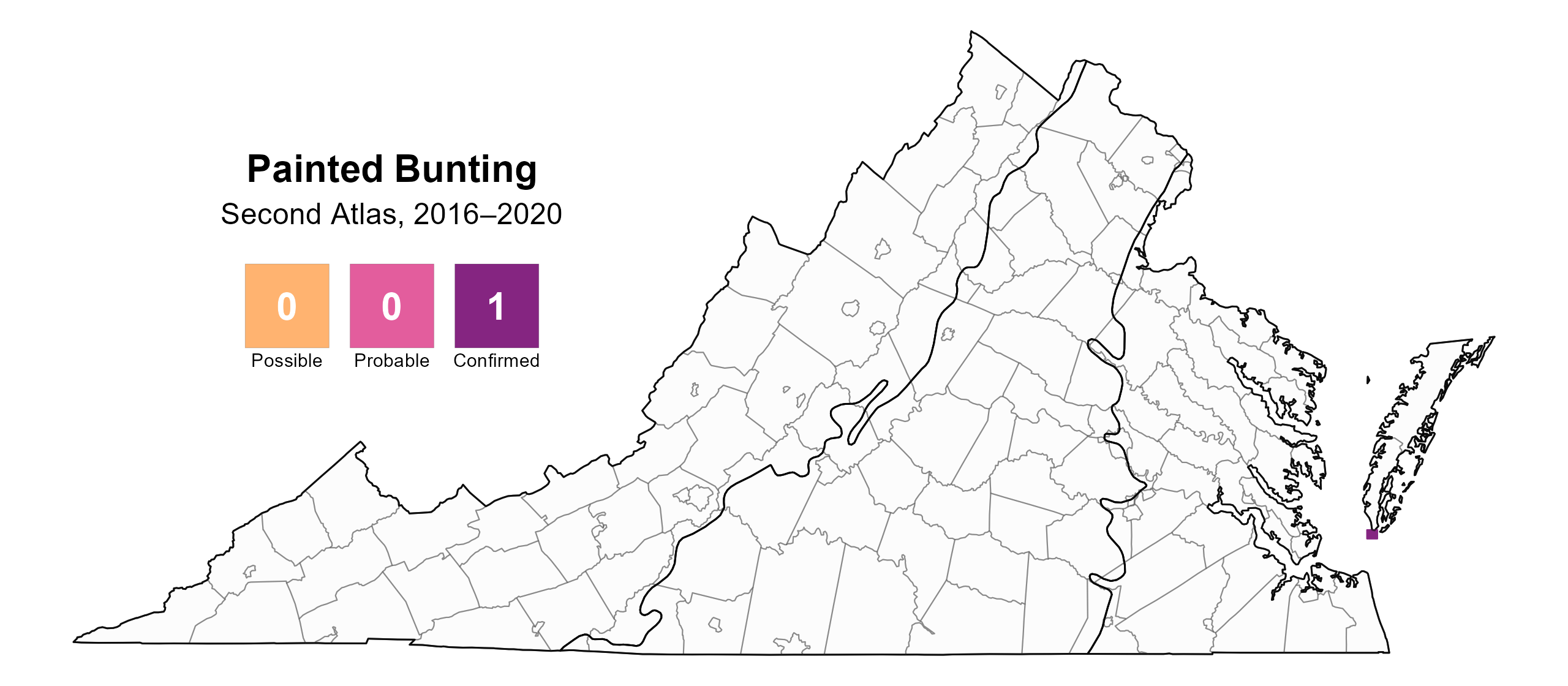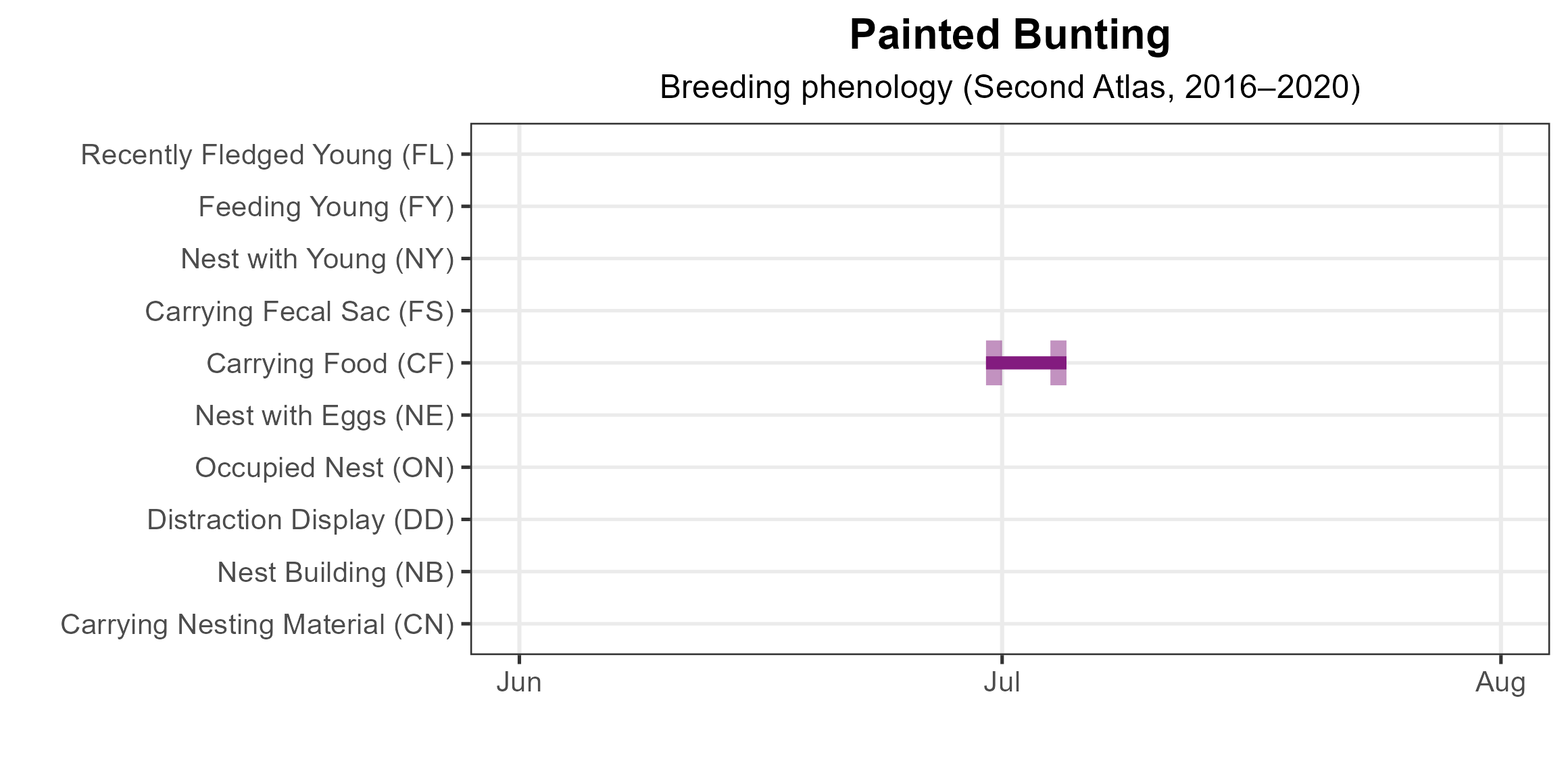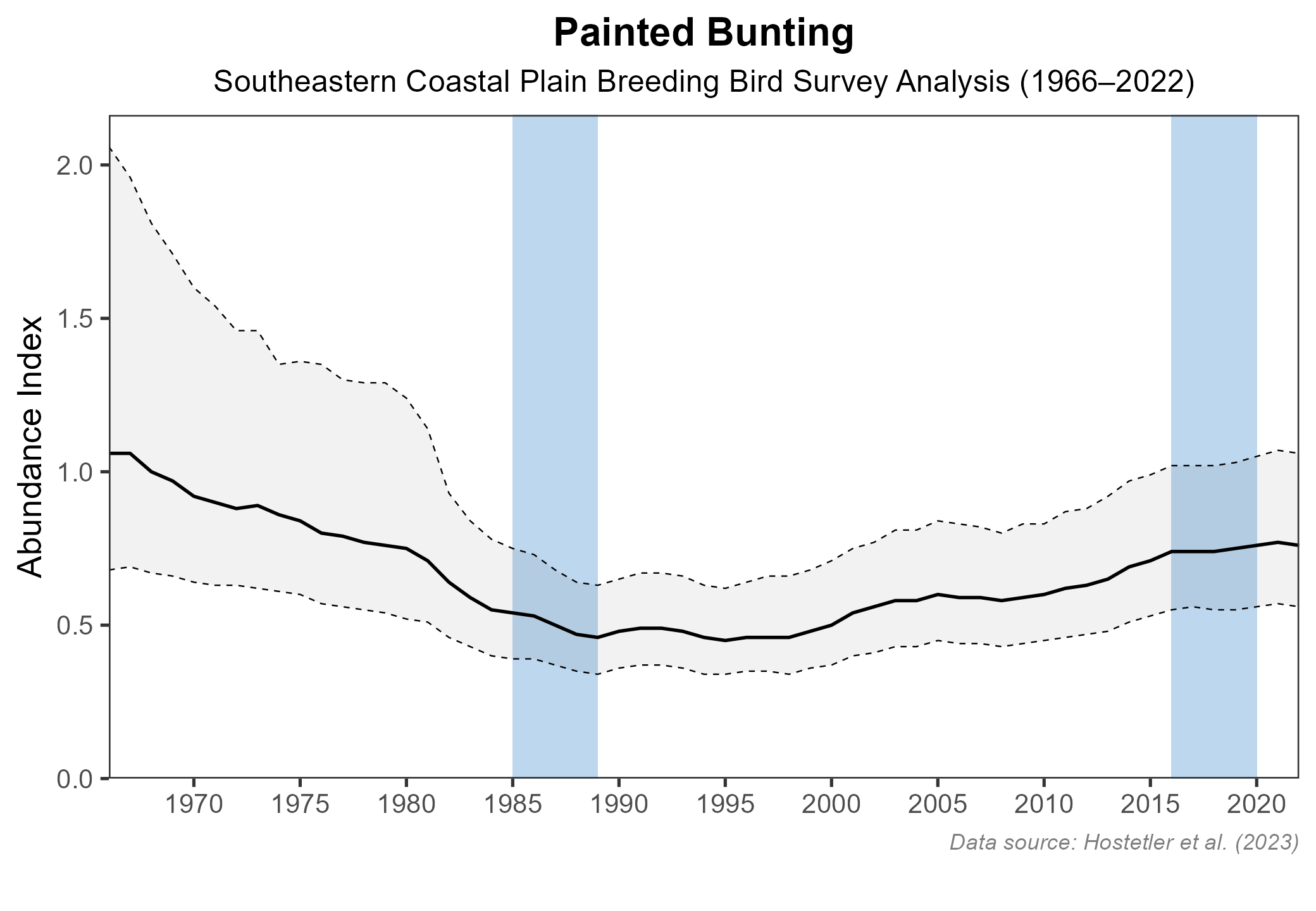Introduction
The Painted Bunting, adequately called the “nonpareil” for its unparalleled coloration, is a striking sight that is more familiar in the Deep South than in Virginia. Females are avocado-green, and males are spectacularly gaudy in blue, red, and green. In Virginia, Painted Buntings are not regular residents but are annual winter visitors at feeders in the southeastern portion of the state, primarily in the vicinity of Virginia Beach (Rottenborn and Brinkley 2007). Although Painted Buntings regularly wander north of their breeding range during fall (Lowther et al. 2020), they were not known to nest in Virginia prior to the Second Atlas. Virginia’s breeding buntings represent a slow expansion of the eastern population, which breeds along the Atlantic Coast from Florida to North Carolina (and now Virginia).
Breeding Distribution
Because the species is rare, its distribution could not be modeled. For information on where Painted Buntings occur in Virginia, please see the Breeding Evidence section.
Breeding Evidence
The Painted Bunting is a new breeding species for Virginia, with breeding first documented during the Second Atlas at Fisherman Island National Wildlife Refuge (NWR) in Northampton County (Figure 1). This single location at the northern end of the Chesapeake Bay Bridge-Tunnel is characterized by hard-to-access scrubby coastal areas, thick with vegetation and ticks, characteristic of the Painted Bunting’s preferred habitat (Lowther et al. 2020; Meyers 2011). In the summer of 2017, two adult males were observed carrying food to nests deep within saltbush (Baccharis halimifolia). Although no fledglings or females were observed, food-carrying behavior was noted between June 30 and July 4 (Figure 2). This discovery represents the northernmost known breeding population in eastern North America.
For more general information on the breeding habits of the Painted Bunting, please refer to All About Birds.

Figure 1: Painted Bunting breeding observations from the Second Atlas (2016–2020). The colored boxes illustrate Atlas blocks (approximately 10 mi2 [26 km2] survey units) where the species was detected. The colors show the highest breeding category recorded in a block. The numbers within the colors in the legend correspond to the number of blocks with that breeding evidence category.

Figure 2: Painted Bunting phenology: confirmed breeding codes. This graph shows a timeline of confirmed breeding behaviors. Tick marks represent individual observations of the behavior.
Population Status
The increasing number of sightings in Virginia over the past several decades, coupled with the discovery of a small breeding population, suggests the species may be increasing in the state. The North American Breeding Bird Survey (BBS) showed no significant change within the southeastern Coastal Plain region, with a decrease of 0.56% per year from 1966–2021; however, BBS data are sparse for the eastern population (Sauer et al. 2022). Despite this apparent stability in the region, Painted Buntings face several threats (see the Conservation section).

Figure 6: Painting Bunting population trend for the Southeastern Coastal Plain region as estimated by the North American Breeding Bird Survey. The vertical axis shows species abundance; the horizontal axis shows the year. The solid line indicates the estimated population trend; there is a 97.5% probability that the true population trend falls between the dashed lines. The shaded bars indicate the First and Second Atlas periods.
Conservation
The Painted Bunting is threatened by the destruction of coastal nesting habitat and illegal trapping of live birds within its wintering range, which can be described as a death by a thousand cuts (Heisman 2021). Eastern Painted Buntings winter in southern Florida and the Caribbean, where these threats are both present. The Eastern Painted Bunting Working Group, including partners such as the Atlantic Coast Joint Venture, has undertaken dedicated sampling to understand the species’ distribution and density in the southeast and the steps needed to conserve them.
Painted Buntings easily adapt to yard and garden habitats, including birdfeeders, throughout their range. If the species continues to expand in Virginia, then it may become more common in new areas where it can be more easily monitored. Consequently, Virginians are likely to become more familiar with this species in the coming decades.
Interactive Map
The interactive map contains up to six Atlas layers (probability of occurrence for the First and Second Atlases, change in probability of occurrence between Atlases, breeding evidence for the First and Second Atlases, and abundance for the Second Atlas) that can be viewed one at a time. To view an Atlas map layer, mouse over the layer box in the upper left. County lines and physiographic regional boundaries (Mountains and Valleys, Piedmont, and Coastal Plain) can be turned on and off by checking or unchecking the box below the layer box. Within the map window, users can hover on a block to see its value for each layer and pan and zoom to see roads, towns, and other features of interest that are visible beneath a selected layer.
View Interactive Map in Full Screen
References
Heisman, R. (2021). The Eastern Painted Bunting: flashy colors, mixed fortunes. American Bird Conservancy: Bird Calls.
Lowther, P. E., S. M. Lanyon, C. W. Thompson, and T. S. Schulenberg (2020). Painted Bunting (Passerina ciris), version 1.0. In Birds of the World (S. M. Billerman, Editor). Cornell Lab of Ornithology, Ithaca, NY, USA. https://doi.org/10.2173/bow.paibun.01.
Meyers, J. M. (2011). Population densities of Painted Buntings in the southeastern United States. Southeastern Naturalist 10:345–56. https://doi.org/10.1656/058.010.0213.
Rottenborn, S. C., and E. S. Brinkley (Editors) (2007). Virginia’s birdlife: An annotated checklist. 4th edition. Virginia Society of Ornithology.
Sauer, J. R., W. A. Link, and J. E. Hines (2022). The North American breeding bird survey, analysis results 1966–2021: U.S. Geological Survey Data Release. U.S. Geological Survey, Laurel, MD. https://doi.org/10.5066/P9SC7T11.


